Introduction
You’ve likely come across the growing conversation around AI use cases in manufacturing for good reason. As someone working in or leading manufacturing operations, you know efficiency and precision are everything. AI isn’t just a buzzword anymore; it’s actively reshaping production lines, maintenance strategies, and decision-making processes. In this post, you’ll explore practical, high-impact ways AI is being applied, so you can start identifying where it fits in your operations.
What is AI and Why Does It Matter in Manufacturing?
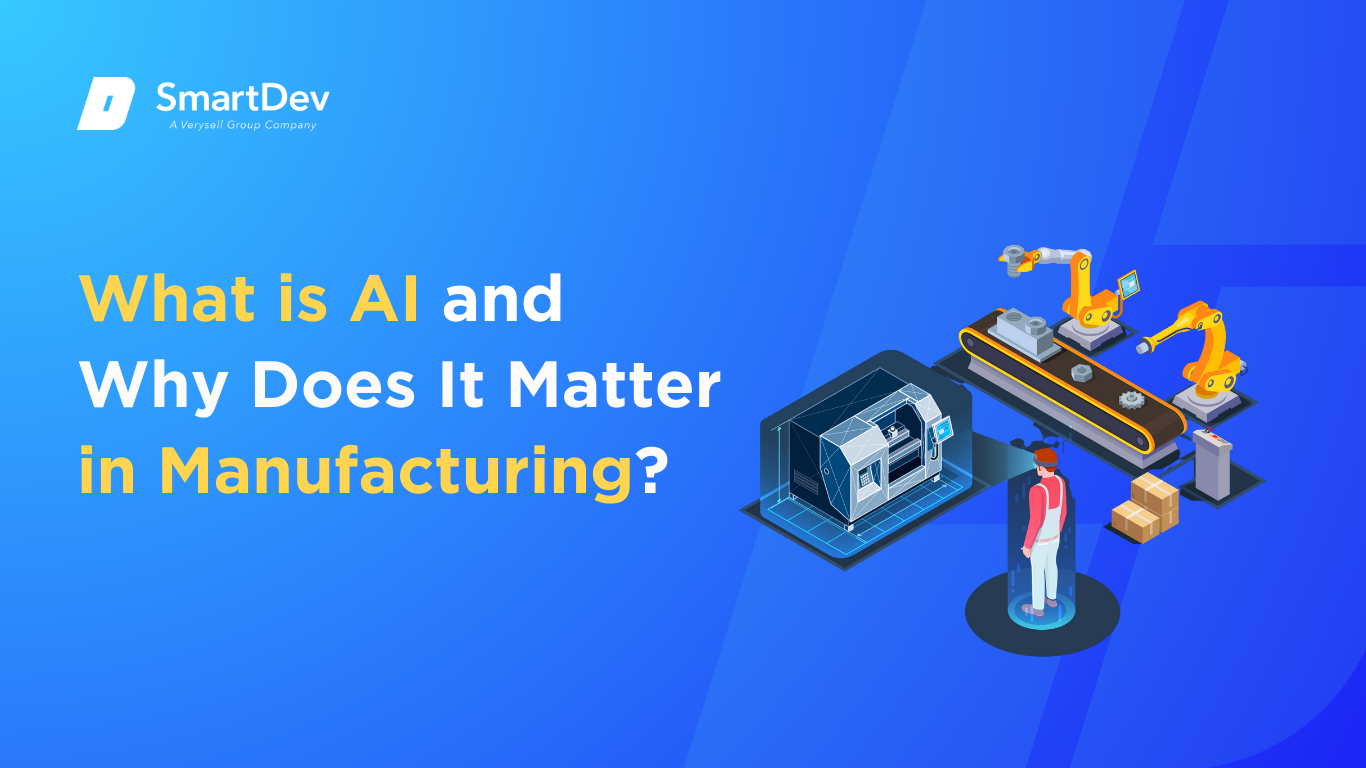
Definition of AI and its core technologies
Imagine you’re overseeing a bustling factory, tasked with boosting the efficiency of the production process. In that time, artificial intelligence (AI) surely becomes your ally, whose systems mimic human intelligence, learning from data to perform tasks and improve over time. With outperformance capabilities, AI in manufacturing possibly enhances efficiency by enabling machines to perceive environments, make decisions, and automate processes with minimal human intervention.
And in that way, AI is defined as encompassing technologies like machine learning for predictive analytics, natural language processing for linguistic interactions, and computer vision for visual data processing, according to IBM. These technologies form the backbone of intelligent automation, driving transformative changes in manufacturing.
More importantly, AI considerably optimizes every facet of production, from shop floors to supply chains, by improving decision-making, automating repetitive tasks, predicting trends, and reducing waste. To do these things, AI itself needs to be equipped with many key technologies including:
- Machine Learning (ML): Learns from data to enhance predictions and decisions.
- Natural Language Processing (NLP): Enables machines to interpret human language for maintenance logs or interactions.
- Computer Vision: Processes visual data for quality control and safety monitoring.
- Robotic Process Automation (RPA): Automates repetitive tasks to boost administrative efficiency.
- Edge AI: Processes data on-site for real-time factory decisions.
By integrating these technologies, manufacturers can achieve unprecedented productivity and innovation, staying competitive in a dynamic market. Discover actionable insights and strategies to seamlessly integrate AI into your operations in 2025. Visit How to Integrate AI into Your Business in 2025 to get started today and unlock the full potential of AI for your business!
The Growing Role of AI in Transforming Manufacturing
In this day and age, manufacturing has entered a new era where AI isn’t just enhancing operations but redefining them. AI enables factories to transform into smart ecosystems capable of real-time data exchange, adaptive learning, and self-optimization.
As I mentioned before, AI is deployed across multiple manufacturing stages: from R&D to production, logistics to customer service. To help you imagine more easily, I will take an example related to this. In an IT news that I read 2 years ago, AI-powered digital twins could allow manufacturers to simulate processes digitally before implementation, reducing risks and costs.
In particular, BMW has deployed a virtual factory using Nvidia’s Omniverse platform to simulate and optimize electric vehicle assembly lines at its Regensburg plant. Meanwhile, generative design powered by AI is revolutionizing how products are conceptualized and iterated. So, it can be seen that AI has been playing a crucial role in enabling mass customization by analyzing customer preferences and aligning.
Key Statistics and Trends Highlighting AI Adoption in Manufacturing
If I just argue like that, perhaps you would suspect how and at what level AI use cases are in manufacturing. And it’s kind of the norm since AI is pretty new in this category, especially to SMEs. Below, I will give you more detailed statistics that can help you judge correctly the potential of AI in manufacturing.
- 60% of global manufacturers use AI to some extent in their operations (McKinsey, 2024).
- 30% reduction in equipment downtime through AI-based predictive maintenance systems.
- 20% productivity increase in smart factories powered by AI (Capgemini Research Institute).
- $25 billion is projected as the global AI in manufacturing market value by 2027, growing at a CAGR of 45.6% (Market Research Future).
- 80% of industry leaders agree that AI will be critical for staying competitive over the next five years (Deloitte, 2023).
These trends underscore that AI is not just a technological upgrade-it’s a strategic imperative for manufacturers aiming to thrive in the Industry 4.0 landscape.
Business Benefits of AI in Manufacturing
Forget the hype, let’s talk about what AI can do for your manufacturing operations. When you look beyond the flashy statistics, you’ll discover concrete benefits that can transform how you do business. Here’s what you can realistically expect when implementing AI in your facilities.
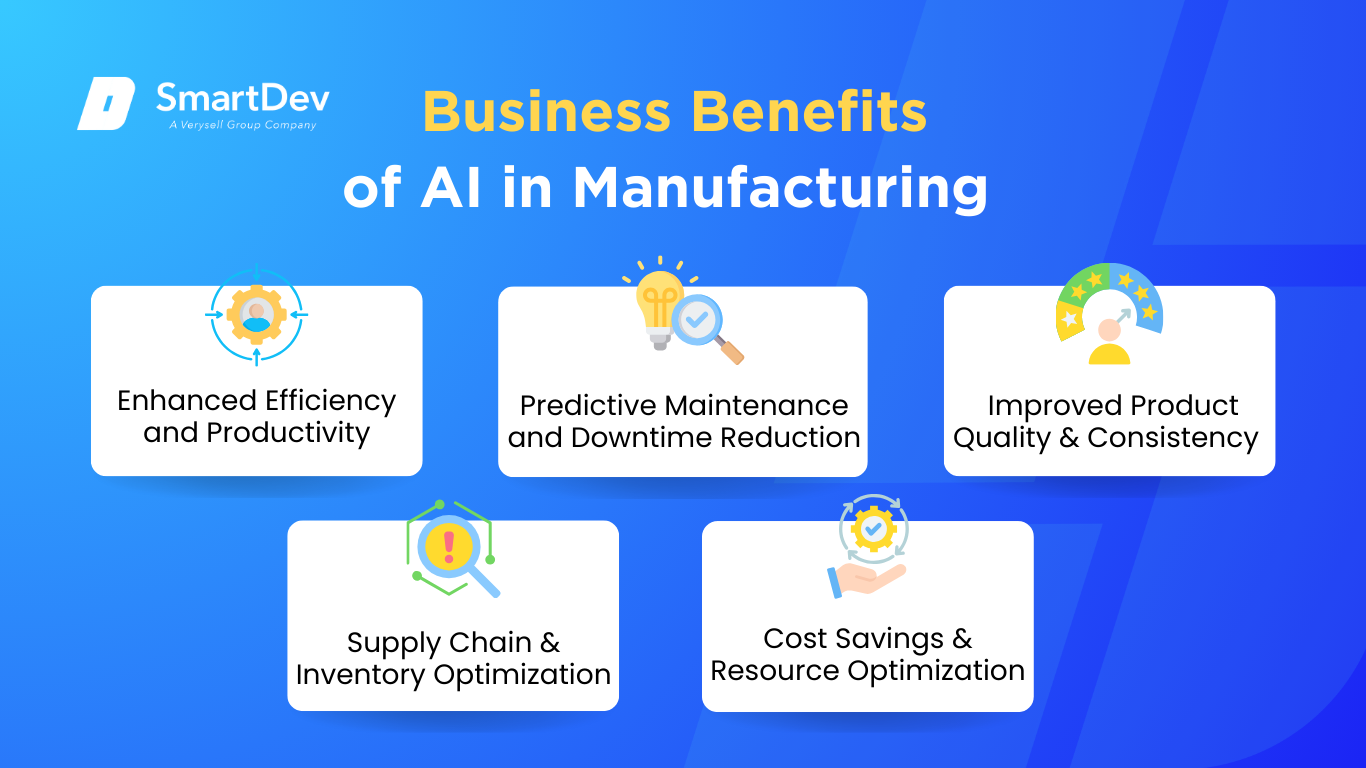
1. Enhanced Efficiency and Productivity
Imagine cutting through the operational bottlenecks that have frustrated you for years. That’s exactly what happens when you deploy AI in your production environment. Your AI systems will take over those repetitive tasks that consume valuable time, fine-tune your production schedules based on actual demand patterns, and make split-second decisions that humans simply can’t match.
The numbers speak for themselves: you’re looking at potentially doubling your throughput while significantly reducing cycle times. Your machinery-those expensive assets you’ve invested in-will finally operate at their designed capacity. Best of all? These improvements translate directly to your bottom line in ways you can measure and report to stakeholders.
2. Predictive Maintenance and Downtime Reduction
Remember the last time a critical machine failed without warning? The rushed repairs, the production delays, the missed deadlines, the unhappy customers? AI makes those scenarios increasingly rare. By implementing predictive maintenance powered by AI, you’ll have systems constantly monitoring the health of your equipment-detecting subtle changes that human operators would miss.
Just ask the team at Siemens. After implementing AI-based predictive tools, they slashed unplanned downtime by 25%. Think about what that would mean for your operation-fewer emergency repair costs, extended equipment lifespans, and more consistent production schedules. Your maintenance team shifts from firefighting to strategic planning, and your customers get their orders on time.
If you want to understand deeper about how AI can use in predictive maintenance and downtime reduction, you can read more at AI Predictive Maintenance in Manufacturing Industry: Maximize Uptime & Efficiency by SmartDev.
3. Improved Product Quality and Consistency
Quality control has always been a challenge-human inspectors get tired, miss things, and can’t possibly check every product with the same level of scrutiny. That’s where AI-powered vision systems become your quality department’s best asset.
These systems inspect your products with microscopic precision, spotting defects that would be invisible to the human eye. What does this mean for you? Early detection of quality issues before they become expensive problems. Consistent quality across every production run, regardless of shift or time of day. Dramatically reduced rework and scrap rates that save both materials and labor. Your customers will notice the difference through better products, and your warranty claims will drop accordingly. Quality isn’t just about reputation-it directly impacts your profitability.
4. Supply Chain and Inventory Optimization
Supply chain disruptions happen-but they don’t have to catch you off guard. With AI-driven demand forecasting, your supply chain transforms from reactive to proactive. You’ll adjust procurement and production based on real-time market signals, not outdated forecasts or gut feelings.
The practical impact? You’ll prevent both costly stockouts that frustrate customers and excessive inventory that ties up your capital. Your logistics planning improves as well, optimizing delivery routes and shipment timing. The result is faster deliveries at lower costs-all while maintaining the perfect order fulfillment your customers expect. In today’s volatile markets, this supply chain resilience isn’t just nice to have-it’s essential for survival.
5. Cost Savings and Resource Optimization
Every manufacturer is looking to control costs, but AI takes this effort to another level. From smart systems that automatically adjust energy usage based on production needs to optimized labor allocation that maximizes every team member’s productivity, you’ll see operational savings across your facility.
The manufacturers we work with typically report up to 20% savings on energy and raw materials after implementing AI resource management. That’s not just good for your profit margins-it’s good for your sustainability goals too.
In an era where both customers and investors increasingly value environmental responsibility, these efficiency gains become powerful selling points. You’re not just saving money today-you’re positioning your business for competitive advantage in tomorrow’s more demanding markets.
Challenges Facing AI Adoption in Manufacturing
Let’s face it-AI promises amazing benefits for your manufacturing operations, but the implementation journey isn’t always smooth sailing. Before you dive in, let’s explore the challenges you’ll need to navigate for successful adoption.
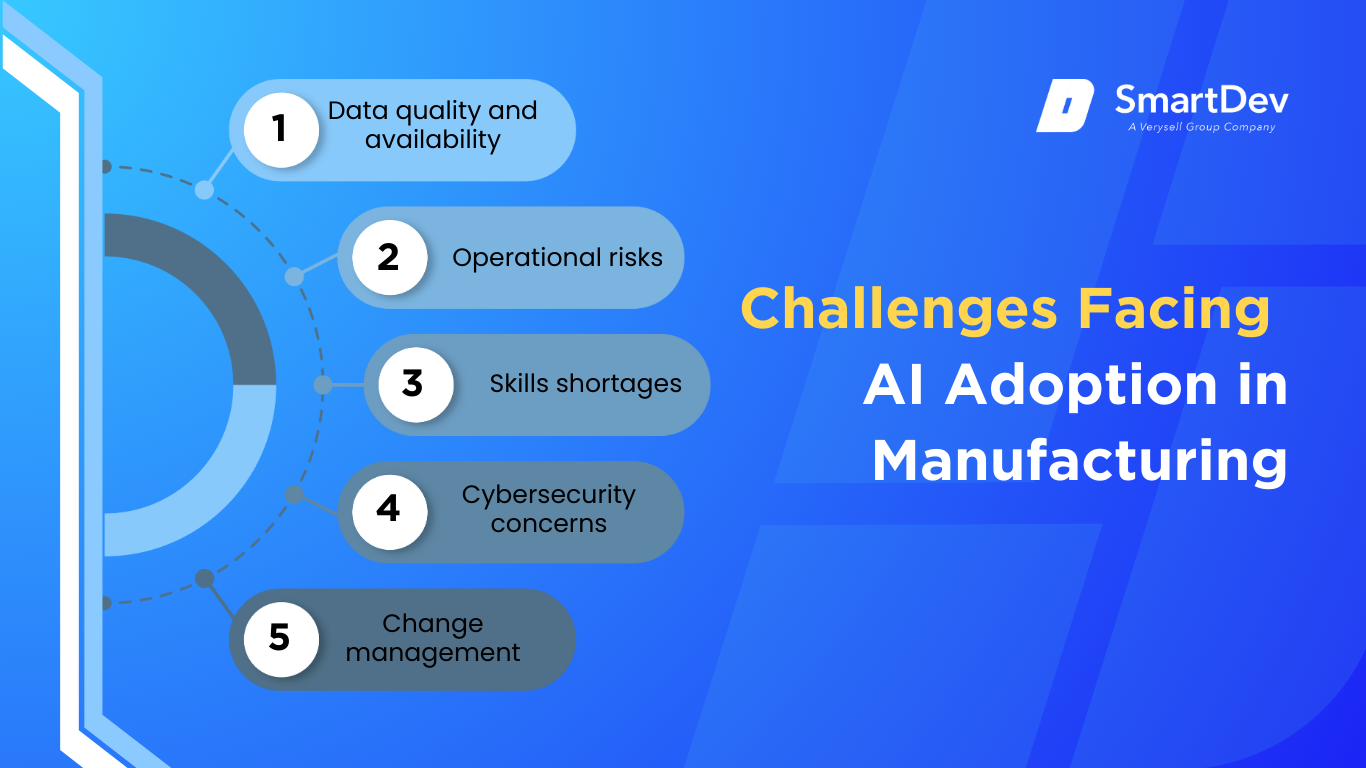
1. Data Quality and Availability
You can’t build a smart factory on a shaky data foundation. If you’re like most manufacturers, you’re dealing with isolated systems that don’t talk to each other.
Your production lines probably collect data differently, your sensors vary in age and accuracy, and you might be missing historical data that would make predictions actually useful.
Remember what happened at Johnson Controls? They discovered 65% of their AI project time went to just preparing data, not building cool algorithms.
The takeaway? Get your data house in order first. Before you invest in fancy AI tools, make sure you’ve got clean, accessible data across your operations-otherwise, you’re setting yourself up for frustration.
2. Operational Risks
It’s tempting to let AI handle everything, but what happens when things go sideways? Without the right balance, you risk becoming overly dependent on systems that can fail in ways your team might not understand.
When AI controls critical processes but can’t explain its decisions (the infamous “black box” problem), troubleshooting becomes a nightmare.
Your smartest move? Start small and keep humans in the loop. The manufacturers seeing real success with AI implement changes gradually, with clear rollback plans if something goes wrong.
They let AI prove itself on less critical systems before handing over the keys to core operations. This way, you get the benefits without betting the farm on unproven technology.
3. Skills Shortages
You’re not just competing with other manufacturers for AI talent-you’re also up against tech giants with deep pockets.
Even if you’re able to hire specialized data scientists, they are in short supply, particularly if your facilities are not located in major tech hubs.
While your current team excels at their roles, they may not have the specialized training required to implement and manage AI systems.
In this case, hiring external experts with high-level skills and real-world experience can be an effective solution to fill the gaps in your team and help accelerate the deployment of AI projects.
Take a page from Schneider Electric’s playbook. Instead of losing the hiring battle, they created their own “Digital Academy” to build AI skills internally.
This approach cut their external hiring needs by 40% and gave existing employees valuable career growth.
Consider what training programs you could develop to grow your own AI experts-it’s often more sustainable than trying to recruit unicorns.
4. Cybersecurity Concerns
Once you connect your operations with AI systems, you’ve expanded your cybersecurity attack surface in ways you might not have considered.
Your AI algorithms can be fooled by subtle data manipulations. Your IoT sensors-the eyes and ears of your AI-might have security vulnerabilities.
And what about that third-party AI solution you’re considering? It could create data governance headaches you haven’t planned for.
Don’t leave security as an afterthought. Build a defense-in-depth strategy with regular testing focused specifically on AI components.
Create appropriate separations between networks, and develop backup plans for potential breaches. Make security a non-negotiable requirement from day one-your future self will thank you.
5. Change Management
Here’s a truth many companies learn the hard way: the most sophisticated AI solution will fail if your team doesn’t embrace it.
Your employees need reassurance that AI will make their jobs better, not replace them. Your floor managers need to be involved early so the solutions actually address real problems they face daily.
Want to triple your chances of successful adoption? Find AI champions within your existing teams rather than forcing changes from the top down.
These internal advocates can bridge the gap between technical possibilities and practical applications, building trust through small wins.
Remember that AI adoption is as much about people as it is about technology-maybe even more so.
Beyond many benefits, AI has lots of challenges and the important thing is that you need to have a clear and concise understanding about this adoption, from practices, challenges to ethics. You can read more at Master Ethical AI Development: The Definitive Guide by SmartDev.
Specific Applications of AI in Manufacturing
Wondering what AI implementation actually looks like in the real world? Let’s explore how leading manufacturers across different industries are using AI to solve everyday challenges.
These examples might just spark ideas for your own operation.
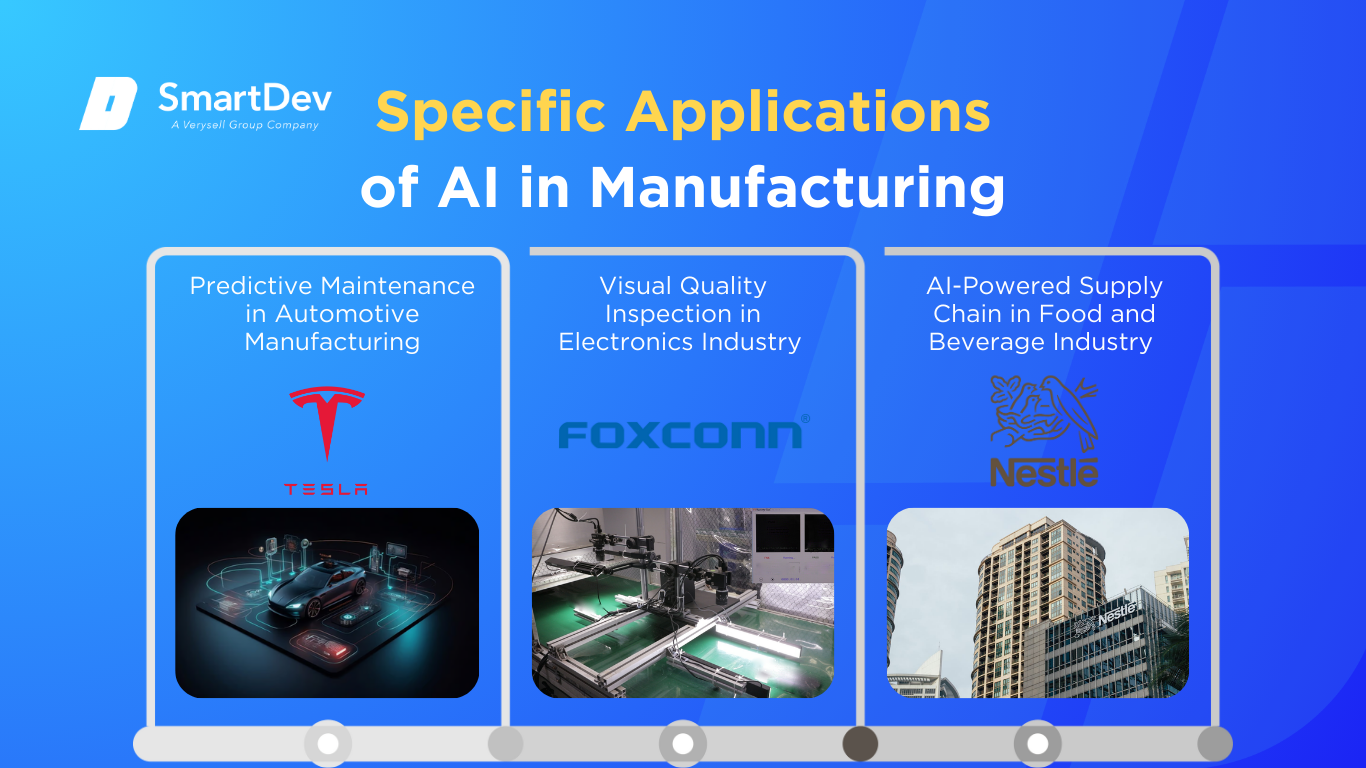
1. Predictive Maintenance in Automotive Manufacturing
Ever had a critical machine break down right in the middle of a production run? Then you know the pain of unexpected downtime. This is where predictive maintenance shines in automotive manufacturing.
By analyzing real-time sensor data and historical patterns, AI helps you spot trouble before it halts your production line.
For your automotive operation, where machinery rarely gets a break, even a few hours of downtime can derail delivery schedules and inflate costs.
Real-world examples
Tesla doesn’t just make innovative cars-they’re revolutionizing how factories operate too. At their Gigafactories, AI algorithms constantly monitor thousands of data points from equipment sensors.
When something doesn’t look right-perhaps a motor drawing slightly more power than usual or a subtle vibration pattern changing-the system flags it for your maintenance team to address during planned downtime.
The result? Tesla has dramatically reduced those dreaded emergency repairs and keeps their production lines humming with improved asset utilization.
Imagine implementing similar technology and having your maintenance schedule driven by machine needs rather than arbitrary calendars.
2. Visual Quality Inspection in Electronics Industry
Quality control keeps you up at night when you’re manufacturing electronics, doesn’t it? When a defect might be smaller than a human hair, traditional inspection methods simply can’t keep up.
This is where AI-based computer vision systems transform your quality control process. These systems can inspect thousands of units per hour with microscopic precision, catching defects your best human inspectors might miss after hours of focused work.
Real-world examples
Foxconn, the manufacturing partner behind many of your favorite Apple products, faces enormous quality expectations. Their solution? AI-powered visual inspection systems that monitor smartphone assembly lines in real-time.
These systems can detect misaligned components, microscopic scratches, and other imperfections that would be nearly impossible to catch consistently with human inspection alone.
For your electronics manufacturing operation, similar technology could significantly reduce false positives (saving rework costs) while slashing inspection time-all while improving overall quality and customer satisfaction.
3. AI-Powered Supply Chain in Food and Beverage Industry
Managing your supply chain in the food and beverage sector feels like juggling with perishable items, doesn’t it? AI transforms this challenge by giving you unprecedented visibility from farm to table.
Smart algorithms analyze historical demand patterns, seasonal trends, and even social media sentiment to help you optimize inventory levels and anticipate market shifts.
For your food production facility, this means fresher ingredients, less waste, and better fulfilled customer orders.
Real-world examples
Nestlé uses AI systems to create a seamless connection between consumer demand and production planning. Their AI analyzes everything from weather forecasts (ice cream demand spikes aren’t just about seasons) to social media trends that might indicate shifting consumer preferences.
By synchronizing production with these sophisticated demand forecasts, Nestlé has significantly reduced overstock situations and waste-a critical win in the food industry where shelf life is limited.
They’ve also improved product availability and developed more agile responses to market changes.
Your operation could benefit from similar forecasting tools, even at a smaller scale, by connecting production more closely to actual demand signals rather than historical ordering patterns.
To explore more the effective of AI uses case in manufacturing, you can find information about Our projects and solutions we’ve developed in collaboration with our valued clients.
Examples of AI in Manufacturing
Real-World Case Studies
When you’re considering AI for your manufacturing line, it’s natural to wonder what success actually looks like.
Let’s explore three compelling examples of how top-tier companies didn’t just implement AI but did so strategically-with measurable results.
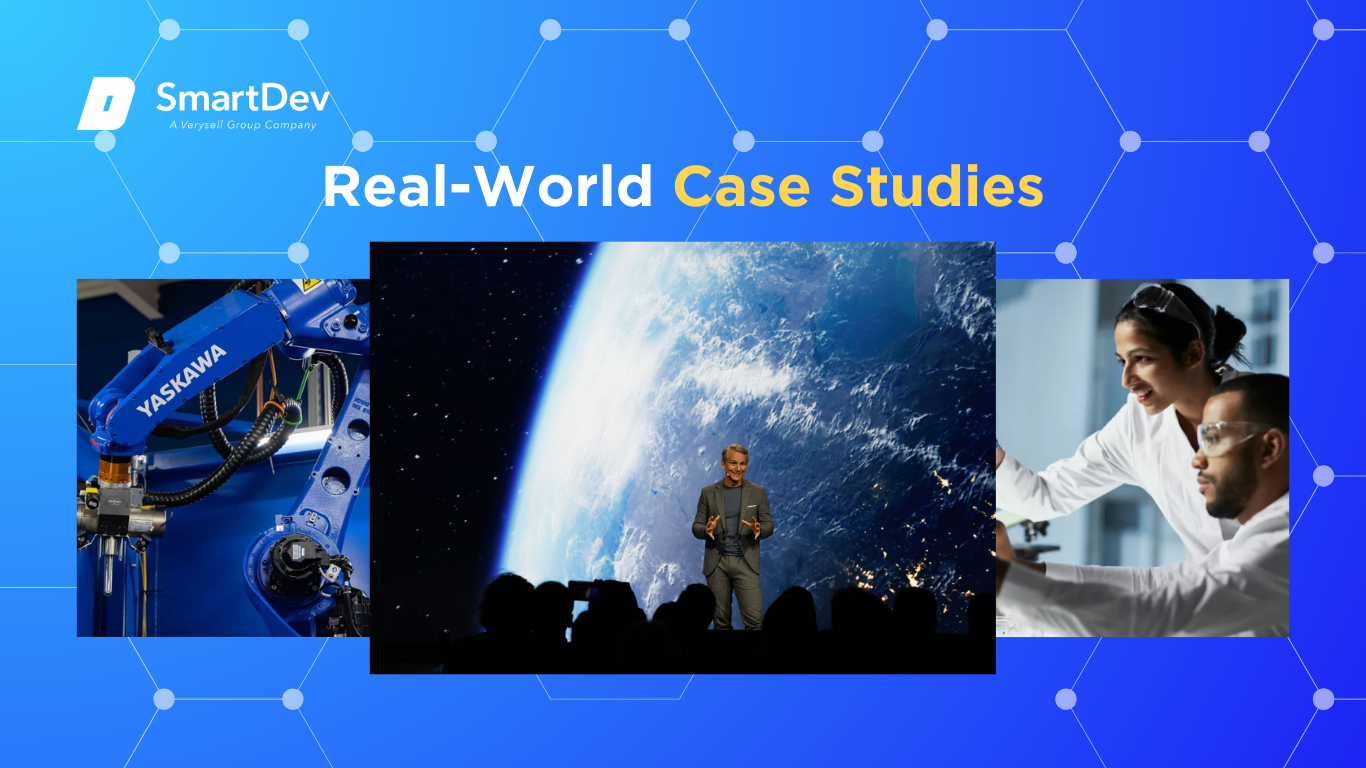
1. Smarter Casting with Siemens
Picture yourself managing a gas turbine production facility. You know that casting imperfections can lead to major losses, delays, and rework. Siemens faced this exact challenge at its Berlin plant.
They developed a digital twin of the casting process and layered AI on top to analyze temperature distribution, material behavior, and cycle timing. Engineers then used this real-time insight to tweak the heating protocols mid-production.
The AI models continuously learned from historical and live data, improving accuracy with each batch. Over time, they reduced the need for human adjustments, allowing autonomous corrections to take place during manufacturing.
The results? 20% drop in defects, 30% faster cycle times, and several million euros in annual savings-not to mention stronger on-time delivery metrics and a significant reduction in energy consumption.
2. Predictive Uptime at GE Aviation
Say you’re responsible for the uptime of thousands of jet engines across the globe. GE Aviation tackled this by embedding AI models into their asset performance management system. These models continuously process data from 35,000+ engines-things like vibration, pressure, and temperature-to detect signs of fatigue before a problem escalates.
The project started by identifying failure-prone components and installing edge sensors to gather operational data. Machine learning models then flagged early indicators of degradation, and engineers fine-tuned thresholds to minimize false positives.
This predictive strategy enabled GE to reduce emergency maintenance events by 20%, saving around $11 million per year, while also increasing aircraft readiness for clients. Additionally, their fleet utilization improved by 5%, contributing to greater operational profitability.
3. Precision and Compliance at GSK with IBM Watson
If you’ve ever worked in pharmaceutical manufacturing, you know how tough it is to maintain consistency across batches. GSK teamed up with IBM Watson to optimize their respiratory drug production. They fed Watson over 15,000 variables from each batch-from ambient humidity to tank pressure fluctuations. Watson’s natural language and statistical reasoning capabilities parsed root causes of deviations across multi-site operations. Engineers created interactive dashboards to visualize batch behavior over time.
The impact? 12% increase in output, 18% fewer rejected batches, and significantly smoother audits thanks to comprehensive data trails. Regulatory reporting, once a bottleneck, became near real-time, saving days of manual documentation effort.
Innovative AI Solutions
Curious about what’s happening on the bleeding edge of tech? Where AI is reshaping the future and transforming factory floors? Let’s explore how pioneering companies are applying AI to break boundaries-and the lessons you can implement today:
1. Generative Design at General Motors (GM)
Ever struggled with designing products that balance performance and sustainability? GM tackled this challenge by partnering with Autodesk to deploy generative AI tools in their early-stage design process.
All you need to do is input your design goals-weight reduction, strength requirements, manufacturability-and the AI serves up dozens of optimized shapes you might never have imagined. These designs get simulated, virtually tested, and even 3D printed in early prototyping.
The result? One suspension component came out 40% lighter, passed every durability test, and saved raw materials-crucial in today’s cost-conscious business environment. The new designs also streamlined part assembly times, shaving off an additional 15% from production steps.
2. Real-Time Visual Feedback at Samsung Electronics
If you work in high-precision manufacturing like semiconductors, you know tolerances are hair-thin. Samsung implemented AI-powered computer vision that monitors wafer etching and alignment in real time. The AI adjusts etching laser paths based on microscopic pattern shifts and generates visual heatmaps of defect risks.
These insights enable technicians to proactively halt defective batches before they reach later stages. The outcome? An 8-10% yield improvement, dramatically reduced defect-related rework, and strengthened product reliability-critical in the chip supply chain.
3. Proactive Planning with SAP Clients
You don’t need to be a tech giant to reap AI benefits. Companies using SAP’s AI-driven Integrated Business Planning (IBP) suite are seeing real-world wins. The system ingests POS data, seasonal trends, supplier performance, and external disruptions like port delays or weather events. The AI then offers scenario simulations-“what if” models-to suggest how you should shift resources.
Can you guess the results? Businesses report a 15% boost in forecast accuracy, 10-12% reduction in holding costs, and far better resilience during supply chain disruptions like COVID-19. Some firms even saw inventory turnover ratios increase by 1.3x, freeing up working capital.
So when you’re considering AI for your own operations, don’t just think about automation. Think smarter processes, smarter data, and ultimately-smarter business decisions. Because that’s where you’ll find real competitive advantage, share your vision with us.
AI-Driven Innovations Transforming Manufacturing
Curious about what’s happening on the bleeding edge of tech? Where AI is reshaping the future and transforming factory floors? Let’s explore how pioneering companies are applying AI to break boundaries-and the lessons you can implement today:
1. Generative Design at General Motors (GM)
Ever struggled with designing products that balance performance and sustainability? GM tackled this challenge by partnering with Autodesk to deploy generative AI tools in their early-stage design process.
All you need to do is input your design goals-weight reduction, strength requirements, manufacturability-and the AI serves up dozens of optimized shapes you might never have imagined. These designs get simulated, virtually tested, and even 3D printed in early prototyping.
The result? One suspension component came out 40% lighter, passed every durability test, and saved raw materials-crucial in today’s cost-conscious business environment. The new designs also streamlined part assembly times, shaving off an additional 15% from production steps.
2. Real-Time Visual Feedback at Samsung Electronics
If you work in high-precision manufacturing like semiconductors, you know tolerances are hair-thin. Samsung implemented AI-powered computer vision that monitors wafer etching and alignment in real time. The AI adjusts etching laser paths based on microscopic pattern shifts and generates visual heatmaps of defect risks.
These insights enable technicians to proactively halt defective batches before they reach later stages. The outcome? An 8-10% yield improvement, dramatically reduced defect-related rework, and strengthened product reliability-critical in the chip supply chain.
3. Proactive Planning with SAP Clients
You don’t need to be a tech giant to reap AI benefits. Companies using SAP’s AI-driven Integrated Business Planning (IBP) suite are seeing real-world wins. The system ingests POS data, seasonal trends, supplier performance, and external disruptions like port delays or weather events. The AI then offers scenario simulations-“what if” models-to suggest how you should shift resources.
Can you guess the results? Businesses report a 15% boost in forecast accuracy, 10-12% reduction in holding costs, and far better resilience during supply chain disruptions like COVID-19. Some firms even saw inventory turnover ratios increase by 1.3x, freeing up working capital.
So when you’re considering AI for your own operations, don’t just think about automation. Think smarter processes, smarter data, and ultimately-smarter business decisions. Because that’s where you’ll find real competitive advantage, share your vision with us.
How to Implement AI in Manufacturing
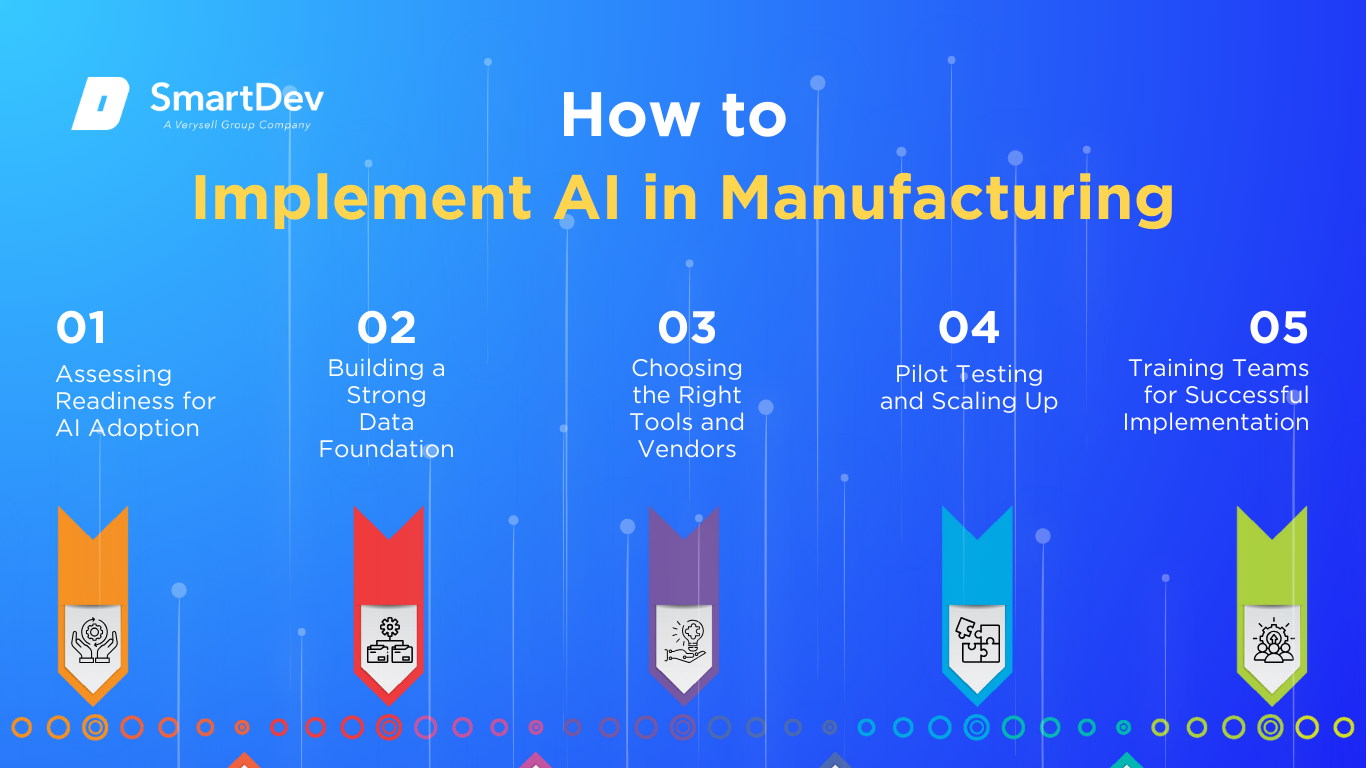
1. Assessing Readiness for AI Adoption
Before deploying AI, you need to evaluate where it fits best. Start by identifying high-impact areas like equipment maintenance, quality inspection, or planning.
Conduct a gap analysis to see whether your current systems can support AI tools-especially around data infrastructure.
2. Building a Strong Data Foundation
AI thrives on data. You’ll need robust pipelines for collecting, storing, and cleaning both structured (e.g., ERP data) and unstructured (e.g., video feeds) data.
Implementing standardized formats and real-time streaming platforms (like Kafka) can vastly improve AI readiness.
3. Choosing the Right Tools and Vendors
Evaluate solutions based on your scale and objectives. Look for vendors that offer APIs and integration flexibility.
Platforms like AWS Lookout for Equipment or Azure AI are becoming go-to choices for predictive maintenance, while SAP’s AI services excel in planning and logistics.
4. Pilot Testing and Scaling Up
Start small. Choose one use case, test it in a limited environment, measure the outcomes, and scale up.
A phased rollout ensures minimal disruption and helps build internal buy-in. Document every step of the pilot to guide future deployments.
5. Training Teams for Successful Implementation
Even the best AI system is ineffective without skilled people. Upskill existing teams in data literacy and AI tools through workshops, certifications, and vendor-led training.
Encourage cross-functional collaboration so data scientists and operations managers work together.
From predictive maintenance to smart supply chain management and AI-driven quality control, the potential is limitless. Contact our team to discover custom AI solutions that optimize your manufacturing operations, boost efficiency, and drive growth.
Measuring the ROI of AI in Manufacturing
Key Metrics to Track Success
To understand the true impact of AI in your operations, it’s essential to go beyond anecdotal wins and focus on metrics that align with business outcomes.
Here are some key KPIs to measure:
1. Downtime Reduction (in machine hours or %)
One of the most direct impacts of predictive maintenance.
For example, if a bottling line previously experienced 20 hours of unplanned downtime per month and AI brought it down to 8, that’s a 60% improvement-translating to increased throughput and reduced labor costs.
2. Defect Rate Improvements
Quality inspection AI can detect minute deviations that humans might overlook.
A drop from 3.5% to 1.2% in defect rates not only improves customer satisfaction but also reduces rework and scrap, saving both time and materials.
3. Energy Usage per Unit of Output
Particularly critical in energy-intensive sectors like steel or chemicals.
AI can optimize energy consumption patterns during low-load periods or automate shutdown/startup processes.
A 10% reduction in kWh per unit output can significantly impact operating expenses.
4. Forecast Accuracy
AI can boost demand planning accuracy by integrating internal sales data with external factors like seasonality or macroeconomic indicators.
An increase in forecast accuracy from 70% to 85% could reduce excess inventory and improve working capital efficiency.
5. Time-to-Decision in Operations
AI-enhanced dashboards can shrink decision-making cycles-from hours to minutes.
Faster decisions on supply chain reroutes, for instance, can be the difference between meeting or missing a critical delivery window.
Understanding ROI is possibly a challenge to many businesses and institutions as different in background, cost.
So, if you need to dig deep about this problem, you can read AI Return on Investment (ROI): Unlocking the True Value of Artificial Intelligence for Your Business.
Case Studies Demonstrating ROI
Let’s take a deeper look into how companies have quantified returns on AI investments:
1. Bosch – AI in Visual Quality Inspection
Bosch deployed machine learning models across three of its automotive component plants to inspect surface defects on brake calipers.
The project required 3 months of model training using historical defect images.
Post-deployment, Bosch saw a 25% reduction in scrap rate and $1.2 million saved annually by reducing waste and rework.
Moreover, defect detection accuracy rose from 89% (manual) to 97.6% (AI-assisted), significantly improving product consistency.
2. ABB – Robotics Optimization for Electronics
ABB introduced AI-based adaptive control systems in its circuit board assembly lines.
These systems continuously fine-tuned robotic arm parameters (e.g., pressure, speed, angle) using feedback loops.
This reduced assembly time per unit by 18%, halved setup time for new product runs, and improved overall equipment effectiveness (OEE) by 11%.
The initiative paid for itself within 8 months and is now being scaled globally.
3. Unilever – AI-Driven Demand Forecasting
Unilever collaborated with a cloud AI provider to refine its global demand forecasting.
Using data from POS systems, social media sentiment, and weather trends, the AI engine made weekly SKU-level demand predictions.
As a result, Unilever reduced safety stock by 15%, lowered inventory holding costs by $50 million per year, and improved service levels across key markets by 7%.
Common Pitfalls and How to Avoid Them
Even with AI’s tremendous potential in manufacturing, implementation challenges can derail your success.
Here’s your roadmap to navigate the most common obstacles.
1. Data Readiness Challenges
Many manufacturers rush into AI projects without establishing proper data foundations, resulting in disappointing model performance.
Start by investing in comprehensive data governance frameworks, centralized data lakes, and efficient ETL pipelines before launching AI initiatives.
This preparation ensures your algorithms have the quality inputs needed for reliable outputs and prevents costly rework later.
2. Transparency Issues
Overreliance on black-box AI models may deliver initial accuracy but often erodes crucial stakeholder trust when decisions can’t be explained.
Implement Explainable AI (XAI) approaches like SHAP or LIME to provide transparency into how your models make recommendations.
This visibility builds confidence among engineering teams who need to understand AI reasoning and satisfies compliance requirements in regulated manufacturing environments.
3. Organizational Resistance
AI implementation fundamentally changes workflows and responsibilities across your organization.
When teams feel blindsided by these shifts, even the most promising technologies face adoption barriers.
Prevent resistance by engaging stakeholders early, identifying departmental change champions, and developing communication strategies that clearly connect AI capabilities to meaningful outcomes for each team member.
4. Degrading Performance
Many companies overlook that AI systems require ongoing maintenance as manufacturing conditions evolve.
Establish automated feedback mechanisms that continuously compare model predictions against actual outcomes, triggering retraining when accuracy falls below acceptable thresholds.
This continuous learning approach ensures your AI ecosystem remains relevant and valuable as your manufacturing environment changes.
By addressing these challenges proactively, you’ll position your AI initiatives for sustainable success while competitors struggle with implementation hurdles.
Future Trends of AI in Manufacturing
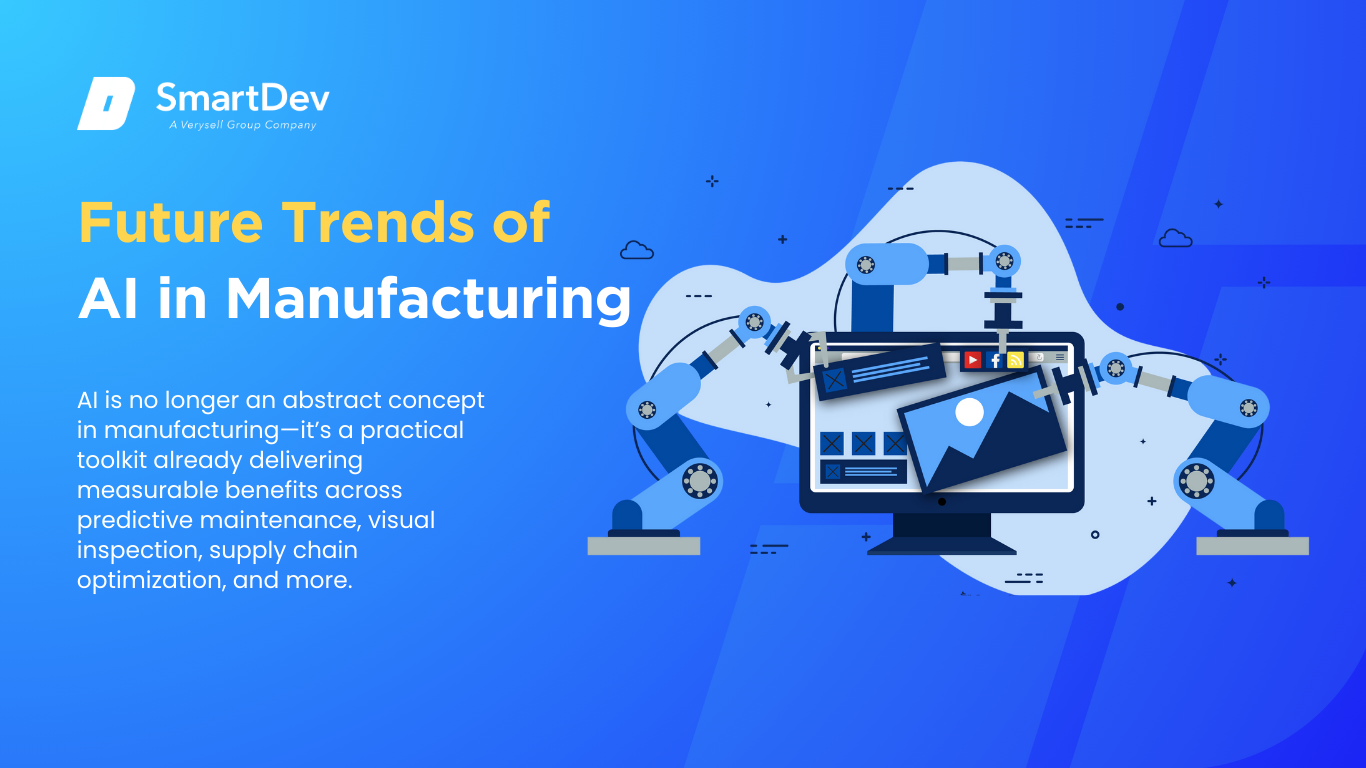
1. Predictions for the Next Decade
AI will transform industrial operations in ways that separate market leaders from followers.
Hyper-personalized manufacturing is emerging as AI advances in generative design enable cost-effective customization at scale.
Forward-thinking companies are shifting to “lot-size-one” production models powered by AI demand forecasting and adaptive manufacturing cells.
Industrial Edge AI brings processing power directly to production equipment, reducing latency and cloud dependency.
This architecture proves crucial for time-critical applications where milliseconds matter-like machine control systems and safety monitoring.
AI-augmented workforces combine human expertise with technological capability.
Voice commands, gesture-recognition, and AI knowledge assistants transform how operators interact with equipment, accelerating training and providing real-time decision support that enhances human capabilities.
Self-healing factories are materializing as AI systems diagnose, predict, and correct issues autonomously.
These operations continuously optimize based on performance metrics and sensor feedback, minimizing downtime beyond what traditional automation achieves.
2. How Businesses Can Stay Ahead of the Curve
To maintain competitive advantage, build flexible data infrastructure with cloud-native platforms, open APIs, and real-time pipelines as the foundation for all future AI initiatives.
Invest in organization-wide AI literacy from machine operators to executives.
This training is becoming as essential as Lean or Six Sigma methodologies were previously.
Drive cross-functional innovation beyond IT and engineering.
Successful implementation requires active participation from procurement, HR, operations, and sales during use case development.
Adopt an experimentation mindset valuing learning over perfection.
Companies that iterate quickly significantly outperform those trapped in endless “proof-of-concept” cycles without implementation.
Conclusion
Key Takeaways
AI is no longer an abstract concept in manufacturing-it’s a practical toolkit already delivering measurable benefits across predictive maintenance, visual inspection, supply chain optimization, and more.
With the right foundation-data readiness, skilled teams, and a strategic vision-manufacturers can significantly reduce costs, improve product quality, and increase operational agility.
The power of AI is real, and it’s transforming manufacturing operations on a global scale.
Moving Forward: A Path to Progress
Whether you’re just starting or ready to scale your AI efforts, the time to act is now.
Begin by evaluating your current maturity, identifying areas with the highest potential for impact, and launching targeted pilots to test your approach.
AI isn’t a silver bullet, but with the right strategy and execution, it can become a catalyst for operational excellence, boosting your competitiveness in an increasingly complex marketplace.
Explore AI solutions tailored for manufacturing at Manufacturing | SmartDev and take the first step toward transforming your business.
The future of manufacturing is here-embrace it today.
—
References:
- Artificial Intelligence (AI) in Manufacturing Market Research Report
- How is AI being used in manufacturing?
- AI use cases in manufacturing
- Five use cases for manufacturers to get started with generative AI
- AI for Manufacturing
- Artificial Intelligence In Manufacturing: Four Use Cases You Need To Know In 2023
- Harnessing generative AI in manufacturing and supply chains
- Impact of AI in Manufacturing: Benefits, Challenges & Uses Case







